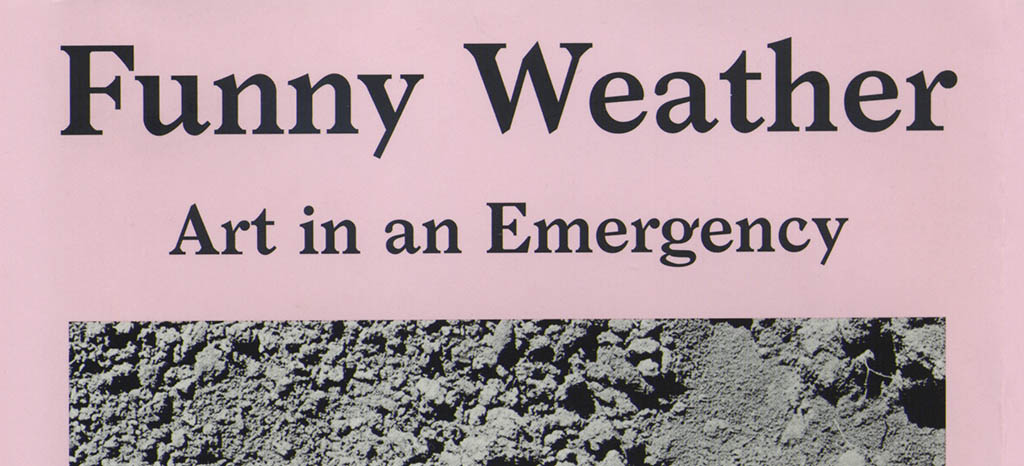Funny Weather is a curated collection of Olivia Laing‘s short pieces of criticism, much of it related to art, some of it related to writing. Olivia Laing identifies as queer. Probably this accounts for a generalized suspicion of power that wafts in the background of all her writing, and for the fact that she champions marginal artists and writers, demonstrating again and again that, although we might describe these people and their creations as marginal, they are in fact essential and we ignore them to our collective impoverishment. Picking up where her previous collection, The Lonely City, leaves off, Laing intensifies her examination of concerns she introduced there, offering a prescient antidote to the plague-induced feeling that these Poe walls are closing in on us, reducing our view of the cultural horizon to the narrow line we see from our tiny windows.
Although published this year, the pieces that comprise this book predate Covid-19 so the book demonstrates no self-awareness of the context into which it makes its appearance. The “funny weather” of her title is restricted to Brexit and Trump, Grenfell Towers and Charlottesville, racist police killings and the repeal of hard-won reproductive rights. As in The Lonely City, Laing views today’s funny weather as a continuation of gusts we felt in the early days of AIDS when the Reagan administration chose not merely to do nothing but actively to make life miserable for hundreds of thousands of those infected. As Laing laments the extraordinary loss American political conservatives wrought upon the face of the entire world, we are left to wonder if, maybe a century or two from now, historians will remember the American experience of AIDS not as a “gay” disease but as the surreptitious evisceration of American cultural life. A hollowing out. Until all we are left with is the echo of our own voices inside an empty garbage can.
That last bleak image is all me. Laing would never say such a thing. She is hopeful. She utterly rejects George Steiner’s claim—based upon the observation that a Nazi commandant could read Goethe and Rilke in the evening and return to his work in the morning, slaughtering Jews—that art has no discernible effect upon a person’s moral dispositions.* Instead, she latches onto a notion developed by the queer theorist, Eve Kosofsky Sedgwick, of Reparative Reading as an antidote to the more familiar habit of Paranoid Reading. We tend to approach reading as the acquisition and absorption of information that will safeguard us against the dozens of tiny terrors that life unleashes against us. Books promise solutions. I have grown suspicious of the recent spate of anti-racist books. Viewed in the most general terms, they are no different from books that offer methods to make money on the stock market or to lose weight or to improve relationships or to investigate the existence of life on faraway planets. In fact, they are no different from click bait on social media sites. They promise to satisfy our hunger for answers in a world that makes no sense. Reparative Reading doesn’t treat the world as a problem to be solved; instead, it treats the spirit as a state to be enlarged.
Laing turns to John Berger for help in describing Sedgwick’s Reparative Reading, in particular his notion of ‘hospitality.’ We read reparatively when we read to open ourselves up, when we encounter other minds with a restless curiosity, when we embrace other ways of being and allow them to remould us. It invites us to encounter our world with generosity. The problem with Steiner’s observation is that it treats reading as a passive activity, like getting a sun tan. We bake ourselves with a little Goethe and Rilke and expect that somehow their words will brown us a little bit. We grow disappointed when we go home from holidays and our skin returns to its familiar washed-out tone. But reading demands something of us. And writing most effectively answers Steiner’s concern when it refuses to pander to the paranoid tendencies of conventional reading and, instead, fosters a spirit of hospitality.
Laing observes of Sedgwick: “Her hope was hard-won, and in part derived from the powerful role art played during the plague years.” She is of course referring to the time when AIDS tore apart the art scene, especially in New York City, but her phrasing (and the timing of her book’s publication) is fortuitous. Readers can’t help but draw a straight line from AIDS in the 80’s to Covid-19 a generation later. At present, we can barely keep up when trying to track the pandemic’s cost in terms of lives lost and economic impact, never mind the cultural cost. It could be a decade, even a lifetime, before we can face squarely the loss we have suffered. As with AIDS, it is a loss inflicted on us not so much by a virus as by an ideology. In the same way, our healing will be effected not so much by the medical establishment as by our artists. It is people like Laing and her contemporary UK to New York transplant, Zadie Smith, who offer us our earliest guidance as to how we might find (re)creation in our art.
* “We know now that a man can read Goethe or Rilke in the evening, that he can play Bach and Schubert, and go to his day’s work at Auschwitz.” From the Preface to Language and Silence: Essays on Language, Literature, and the Inhuman, George Steiner (New York: Open Road, 1966).
Steiner made a similar statement almost 30 years later in an interview with Eleanor Wachtel: “If my work is to have any little echo after me, it will be that I was one of the first to ask this question in an even sharper form: You play Schubert and then go and torture people.” Original Minds, Eleanor Wachtel (Toronto: HarperCollins, 2003).
